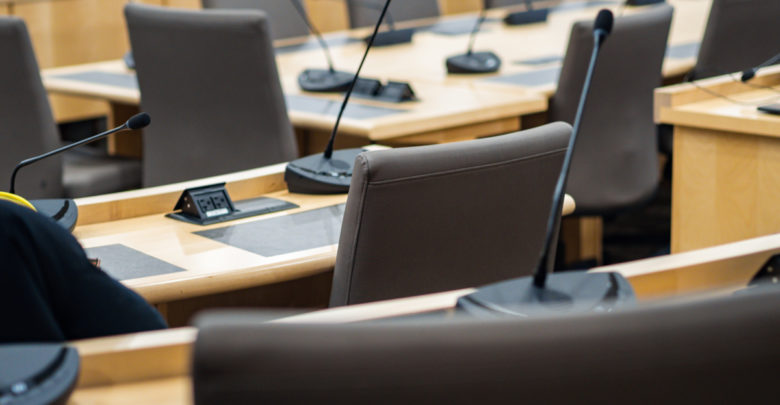Notes from Council: U of A presents proposed tuition increases, two councillors resign
"Student governance has been a disappointing experience," former councillor says.
 Helen Zhang
Helen Zhang“Notes from Council” is The Gateway’s ongoing series of recaps of noteworthy items from Students’ Council meetings.
At the November 29 Students’ Council meeting, the resignation of two councillors was announced, a presentation from the University of Alberta on tuition increases was given, and the Law Students’ Association requested a Faculty Association Membership Fee (FAMF) renewal.
“The institution is sadly run under a veil of privilege and ignorance,” former councillor says
Christian Zukowski, speaker of Students’ Council, announced that he received letters of resignation from Jashan Mahal, a former arts councillor, and Mobashhir Khan, a former science councillor.
Khan resigned due to not having enough time to serve on council, and Mahal resigned due to council being a “disappointing experience.”
“Student governance has been a disappointing experience — or I had unrealistic expectations to begin with. The issues that require genuine attention are often sidelined, or are unfortunately buried under thousands of rules,” Mahal said in their letter of resignation.
“The institution is sadly run under a veil of privilege and ignorance. I don’t have a lot of confidence in the council’s effectiveness or motives, and I am not committed to the process at this point.”
U of A proposes tuition increase of 5.5 per cent, the maximum allowable amount
Melissa Padfield, deputy provost (students and enrolment), presented on the proposed domestic and international tuition increases for the 2023-24 academic year.
The proposed increase on domestic and international tuition for Fall 2023 is 5.5 per cent.
“This is in alignment with the Consumer Price Index, which is actually not a measure we calculate,” Padfield said. “It’s a measure that the Government of Alberta calculates and provides to us.”
Padfield said that because of tuition fee regulations, the Consumer Price Index of 5.5 per cent is the maximum allowable amount for tuition increases.
Regarding the university’s decision to increase tuition at the maximum allowable amount, Padfield said that the increase is “mostly driven by a desire to maintain the quality of academic programming that [students] experience.”
According to Padfield, the U of A calculated that the inflation rate of the university’s expenses is around four per cent, which also affected the decision to increase tuition.
“When we apply that four per cent to our overall costs, the anticipated increase in our expenses will be at $41 million,” Padfield said. “Roughly $26 million of the $41 million would need to be made up by tuition sources.”
Padfield said that tuition covers the salaries of instructors, maintenance of classrooms and study spaces, supplies related to instruction, utilities, maintenance of research that supports instruction, and libraries.
For international students, the 5.5 per cent increase applies to students who entered programs prior to 2020, before the cohort-based tuition plan was introduced.
The cohort-based tuition plan was implemented for students admitted in Fall 2020 and beyond. This plan allows students to know the total cost of their program, by calculating tuition with a program-based model.
For international students entering new programs in 2024, the international cohort-based tuition will be increased by 6.5 per cent.
Students were allowed to participate in question period for this presentation, and an anonymous student submitted a question regarding quality of education.
“I do not feel like I’m paying for quality education,” the student said.
“I’m paying for the printed piece of paper that I’ll receive at the end of my studies; a paper that is becoming increasingly irrelevant in the workplace, as higher and higher degrees are preferred. Why is tuition being hiked without any meaningful changes to the quality of education?”
Padfield encouraged the student to reach out to their faculty if they’re in a particular program, as well as the university, if there are issues with the quality of content in a course.
She also said that a U of A degree is very high quality, and “as we continue to rise in rankings globally, that increases the value of that piece of paper.”
“I recognize for individual students, some of those experiences are not bearing out the way that they had anticipated. We have to do better to make sure that the vast majority of students have the experience they expected when they come, and feel that it is worth the cost of the education that they’re paying for,” Padfield said.
Leo Huang, an arts councillor, said that tuition has grown three times faster than the university’s main cost drivers.
“Why is the university working at another increase when costs haven’t risen into the same degree?” Huang asked.
The U of A has had a $222 million reduction in the last three fiscal years. According to Padfield, one solution to help “bridge that gap” has been academic restructuring.
Restructuring was done to the university’s administrative services, in an effort to increase efficiency of services and reduce administrative costs. “That made up some of the gap,” Padfield said.
“We did a lot of work to make up that gap without putting the burden on students and the costs that you bear. We do still have a gap remaining in addition to the increased [inflationary] costs, and that is why tuition increases have come into play.”
Law Students’ Association requests FAMF renewal
The Law Students’ Association (LSA) FAMF renewal proposal was presented by Alexander Akiki, vice-president (finance).
The LSA is responsible for coordinating community events, providing grants to student groups, and working with the faculty of law to support students academically and professionally.
It is requesting to renew its $50 annual FAMF fee, divided into two payments of $25 per Fall and Winter semester. The fee will begin collection from July 2023 to the first day of classes in September 2023, and will end collection June 1, 2027. Students will have the option to opt-out for two weeks after classes begin in September.




